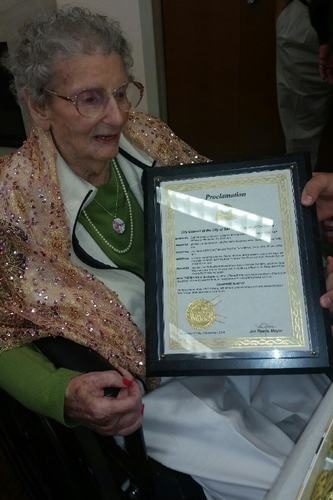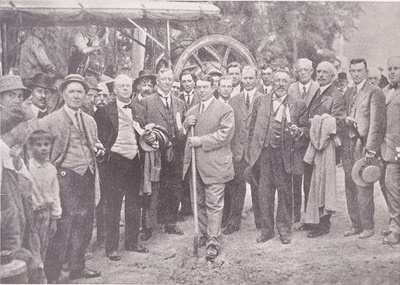-
Use Cases
-
Resources
-
Pricing
San Bruno History
Events
Thorpe's Place (Uncle Tom's Cabin) Opens
1849-01-01
% complete
In 1849, a man named Thorpe moved to the intersection of El Camino Real and San Mateo Ave where he built a 12' x 12' cabin with stables to rest stagecoach horses. It was known as the 14-mile house. In 1871, it was sold to a J. Gamble and named the Star and Garter. In 1875, it was taken over yet again by an ex-slave from Virginia named Thomas Rolle who renamed it Uncle Tom's Cabin. Rolle died in 1879 and August Jenevein managed the cabin until 1889.
Pictured: Uncle Tom's Cabin, 1877
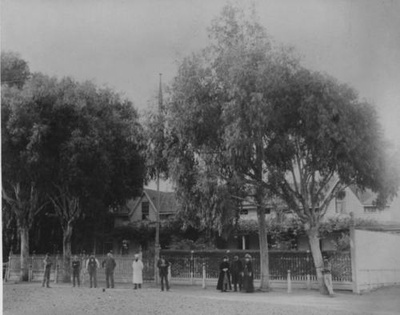
John Tilton Writes to Sister About California
1850-05-01
% complete
John Quincy Adams Tilton left New York in 1850 by steamer ship to make his way to San Francisco. During this time, he wrote a 38-page letter to his sister Georgietta, giving a detailed account of his voyage after reaching Panama, and in particular recounting his passage through the Isthmus of Panama, by canoe and on foot, and up the Pacific coast by the sailing vessel, the Barque Croton. His letter vividly describes the adventure and adversity of the trip, and concludes with travel advice for making the journey. Most of the Tilton family eventually relocated to California, and his parents, Stephen and Julia were among the earliest "Yankee" settlers in San Bruno, building their home on the San Bruno toll road (San Mateo Ave) in 1860.
Pictured: Page 1 of Letter from John Quincy Adams Tilton to his sister Georgietta, written aboard the Barque Croton during the month of April and part of May, 1850
Letter from John Quincy Adams Tilton to his Sister Georgietta
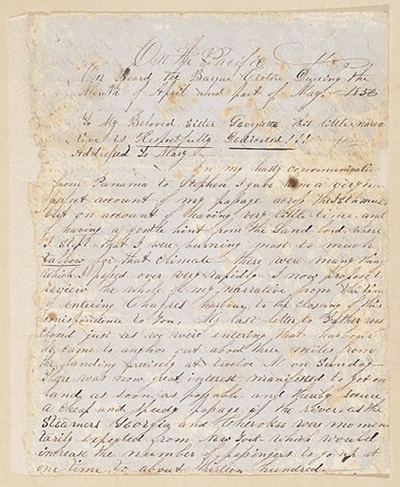
Creation of San Mateo County
1856-04-19
% complete
The California State Legislature passed the Consolidation Act on April 19, 1856, which created San Mateo County from the southern section of what was then the County of San Francisco.
On May 12, 1856, the first election in San Mateo County took place. Voting was held in Crystal Springs Valley (currently Crystal Springs Reservoir), and residents were to elect county officials and choose a county seat.
Pictured: Drawing of the first San Mateo County Courthouse in Redwood City, c 1871
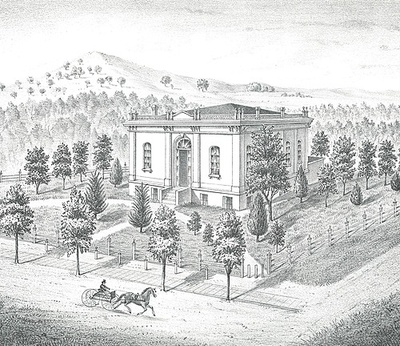
San Mateo Avenue Built
1859-07-01
% complete
"The old 'San Bruno Toll Road' was built in 1859 by enterprising Redwood City investors who were authorized by the State to charge a fee for its use. By 1900, the name was changed to San Mateo Ave to distinguish it from the San Francisco section called San Bruno Ave."
Darold Fredricks, Images of America: San Bruno
Pictured: The 400 block of San Mateo Ave., c. 1950s
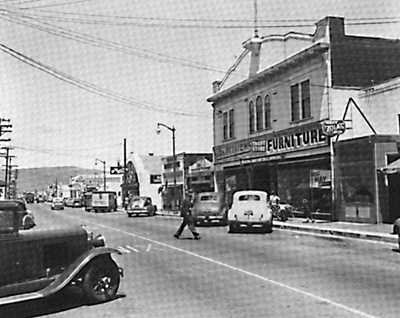
About the Artist
1863-01-01
% complete
This image of the San Bruno House was drawn by Grafton Tyler Brown (1841–1918), an American painter, lithographer and cartographer. It was published in "An Illustrated History of San Mateo County" in 1878. Brown was the first African American artist to create works depicting the Pacific Northwest and California.
Pictured: Grafton Tyler Brown
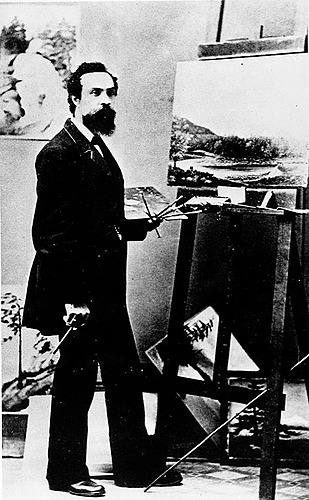
Richard Cunningham Opens the San Bruno House
1863-01-01
% complete
"Richard Cunningham arrived in the United States in 1847 from Ireland. Sensing the need for accommodations for travelers on the Peninsula, he bought an acre of land from the Sanchez estate in 1861 and settled in a newly formed area named San Bruno.
He built a wooden two-story hotel called the San Bruno House on the newly established San Bruno toll road (San Mateo Avenue)."
"The San Bruno House was ideally suited for sporting activities with access to San Francisco and San Jose on the San Bruno toll road and the railroad. The waterfowl in the surrounding marshlands and the wildlife in the hillsides invited hunting and fishing, and no doubt contributed to San Bruno’s development as a vacation spot for San Francisco families. Indeed, the initial efforts to sell property in the San Bruno area to San Franciscans stressed the area’s rural amenities."
Darold Fredricks, San Mateo Daily Journal, January 28, 2008
Pictured: San Bruno House
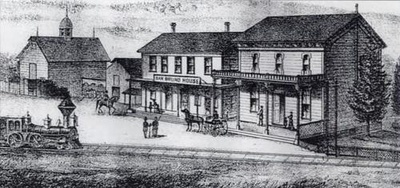
Alfred F. Green In San Bruno
1863-06-25
% complete
Alfred F. Green (1831-1910) was a dairyman and member of the San Mateo County Board of Supervisors. Born in Vermont, he left the east coast for San Francisco in 1853. Green married Mary Tilton, daughter of Stephen Tilton and sister of John Tilton, in 1863 and had a house built in San Bruno just north of Northbrae School. Several years later, Green and his family moved to Millbrae, into a house at 1 Lewis Ave.
Green ran the Mills Dairy in partnership with Darius Ogden Mills for more than 20 years, beginning in 1862. The dairy was one of the largest in the county and shipped large amounts of milk and cream to San Francisco on a daily basis. Green also served on the Board of Supervisors for 30 years.
Pictured: Maggie Green, a maid and former slave who lived with the Green family at their home on Lewis Ave in Millbrae. c. 1905
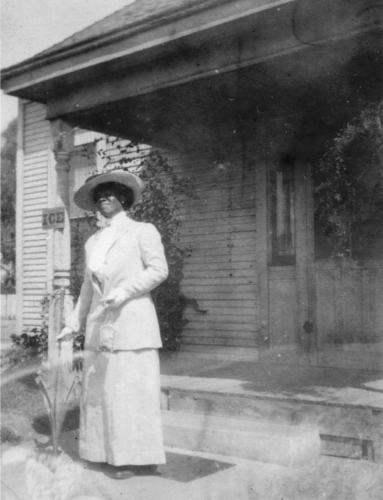
San Francisco - San Jose Railroad Completed
1863-10-01
% complete
Efforts to build a railroad connecting San Francisco to San Jose had been defeated several times before ground was finally broken in May 1861. The railroad was completed in 1863 and regular rail service was established by mid-1864. In 1868, the railroad was absorbed by the large Southern Pacific Railroad, which continued service in the Peninsula until 1963. Tracks for the #40 streetcar line ran alongside the Southern Pacific, and the two systems ferried commuters up and down the Peninsula for decades.
The San Bruno railroad station was first built at Euclid and Huntington Avenues, until being moved to the corner of San Bruno and San Mateo Avenues in 1916.
Pictured: View of San Bruno Train Station looking north. Station located at Huntington and Euclid, June 15, 1916
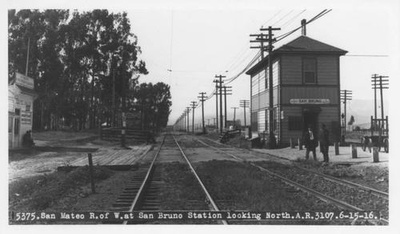
Illegal Boxing Match Takes Place
1866-06-23
% complete
"A prize fight came off at San Bruno Station on Wednesday last, between a gang of San Francisco shoulder shootists. The fight was an open violation of the criminal laws of this state, and is a State Prison offense, the names of the principals in this outrage, are Faylor and Blackey, who it is stated fought for $100 a side, and Thom. McAlpine alias "Soap", and John Devine alias "Chicken" who fought for $100 a side. The first named parties fought 119 rounds and each got well pounded, but the "Chicken" was so badly "soaped" that he couldn't crow. The principals in this affair are well known, and steps should be taken by the proper officers of this county, to have the parties arrested and punished. Any needed assistance necessary, will be rendered by the officers of San Francisco, for the purpose of bringing the offenders to justice."
San Mateo County Gazette, June 23, 1866
Pictured: John Devine
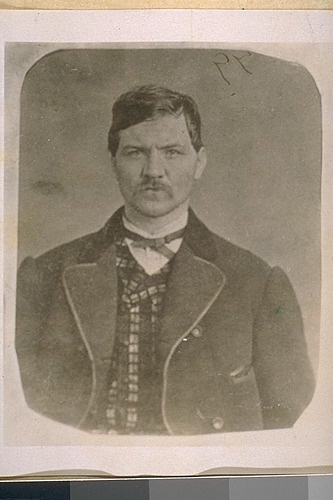
Thorpe's Place Sold to J. Gamble
1871-01-01
% complete
Thorpe's place sold to a J. Gamble and renamed the Star and Garter.
"A flag pole was placed on the roadside, as was the English custom, and this pole became a famous landmark to thousands of travelers over the years."
Darold E. Fredricks, San Bruno History Index, vol. 2
Richard George Sneath Begins Dairy Operations
1875-01-01
% complete
"In 1875, Sneath purchased 1189.22 acres of land in future San Bruno. The property was bounded on the east by El Camino, between present-day Sneath Lane, ran west to Skyline boulevard and north to Westborough boulevard. Sneath added property west of Skyline until his holdings totaled almost 2000 acres extending from El Camino Real to Sweeney Ridge and Pacifica."
Darold Fredricks, San Bruno People and Places
Pictured: Sneath's dairy (center) in San Bruno ran from the El Camino (lower) to Pacifica.
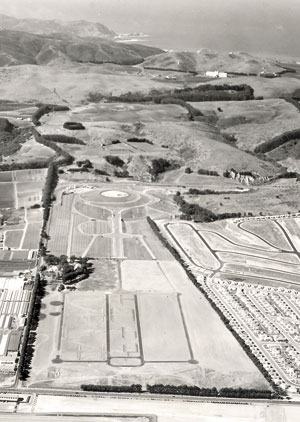
Thomas Rolle Open's Uncle Tom's Cabin
1875-07-01
% complete
One day, a black man, an ex-slave named Thomas Rolle, stopped at the tavern on his way to Searsville where he’d been offered a job as a cook. Gamble made him an offer he couldn’t refuse, so Rolle accepted. Rolle must have brought some terrific recipes with him for it wasn’t long before word spread about the culinary creations "Uncle Tom” was cooking up in the kitchen. Wealthy San Franciscans began stopping there on their way down the Peninsula to their weekend mansions. Soon the tavern was a destination on its own, from both directions.
In 1875, Thomas Rolle promoted himself from cook to proprietor, with some financial help from William C. Ralston, banker, bon vivant and frequent guest. Rolle removed the Star and Garter sign and replaced it with his own. The roadhouse was now officially called "Uncle Tom’s Cabin.” Families often came now, sometimes bringing their own picnic food, and enjoyed the acres of beautiful flowers and trees, including orchards.
August Jenevein Becomes Manager of Uncle Tom's Cabin
1879-07-31
% complete
When the previous owner of Uncle Tom's Cabin, Thomas Rolle, passed away in 1879, August D. Jenevein took over as manager. Jenevein continued as manager until 1889.
"August Jenevein had come from France when he was about sixteen years old. After a stay in New Orleans, he traveled to San Francisco and worked in the restaurant industry there. He moved to San Bruno in 1874. He made the Cabin into a high-class French restaurant with good food and wine to fit the best patrons."
Darold E. Fredricks, San Bruno History Index, vol. 2
Pictured: August and Amelia Jenevein, in their later years, with their children.
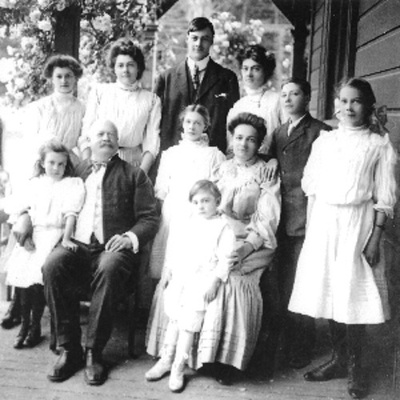
Custodio and Emilia Silva circa 1885
1885-07-01
% complete
"The Silva family began their San Bruno connection when Custodio Silva emigrated from Chile. He worked for the Miller and Lux cattle empire in South San Francisco. In 1871, he purchased 30 acres from a Sanchez heir for $5,000 in gold. The property (present-day location) was located west of El Camino Real and the Tanforan Shopping Center, north of Interstate 380 and south of Sneath Lane. Custodio was a well-known and respected horse dealer, running as many as a thousand horses at any one time on the Rancho location, as well as several other pieces of land he owned or rented. Horses were absolutely essential at that time for transportation, hauling and farming. He sold horses to local buyers, farmers and even the military. The Silva ranch was a gathering place on weekends, not only for his family, but others who came to watch wild horses being "broken” for riding and domestic use."
Darold Fredricks, San Mateo Daily Journal, February 22, 2010
Pictured: Custodio and Emilia Silva
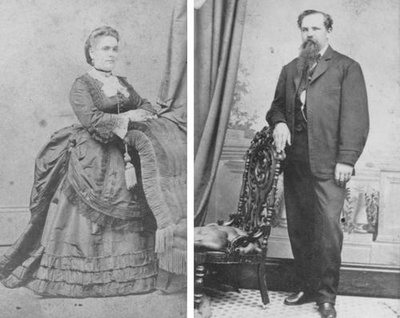
August Jenevein Builds the Junction House
1889-01-01
% complete
In 1877, August Jenevein and his brother bought a five-acre plot at the junction of San Mateo Ave and El Camino Real. In 1889, he built the Junction House, a family-oriented bar, restaurant, and hotel for travelers along the Old Mission Road (El Camino).
Darold Fredricks, San Bruno People and Places
Pictured: Junction House, c. 1889-1900, August Jenevein is on the far right
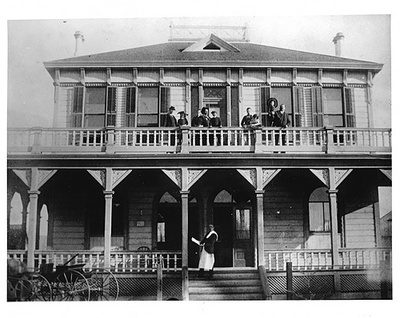
Uncle Tom's Cabin Burns Down
1895-01-01
% complete
Uncle Tom's Cabin, which was located at the intersection of San Mateo Ave and El Camino Real and was originally built in 1849, burns down and is rebuilt.
Pictured: Uncle Tom's Cabin after the rebuild
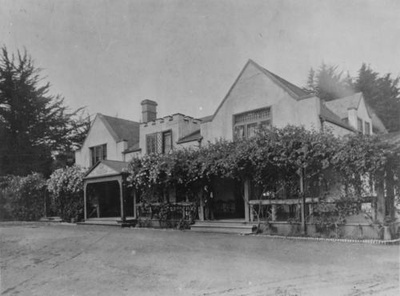
Tanforan Racetrack Opens
1899-11-09
% complete
Tanforan Race Track, owned by the Western Turf Association, opens to the public. Tanforan was the site of horseracing, car racing and air shows; it served as a military training camp during WWI and as a temporary Assembly Center for Japanese Americans during WWII. It continued operations through a number of incarnations until it was destroyed by a fire in 1964.
Pictured: Aerial view of Tanforan, 1923
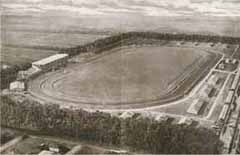
Lombardi Dairy Moves to San Bruno
1900-03-01
% complete
Sebastian Lombardi, born in Switzerland in 1866, emigrated to San Francisco in 1887 where he ran a small dairy at London and Russia Streets. In 1900, the growth of San Francisco began to encroach on his dairy, and Sebastian moved with his wife to what would become San Bruno. He bought 27 acres along San Mateo Ave. and 1500 acres near Belle Air Park, the current location of San Francisco International Airport. The land became known as Lombardi's Fields and the 400 head of cattle roamed the fields were a familiar sight.
The Lombardi family remained active in the San Bruno area for many years. Sebastian was appointed vice-president of the South San Francisco bank and was always involved in local elections and social events. In 1928, Sebastian helped his sons Stephen and August Lombardi start the Pacific Coast Dairy in San Francisco. WWII housing was built on some of the dairy land, the San Bruno Lombardi Dairy remained in operation until 1945.
Assassination of William McKinley
1901-09-06
% complete
President William McKinley was shot by anarchist Leon Czolgosz while attending the Pan-American Exposition in Buffalo, New York. He died of his injuries on September 14.
Pictured: President William McKinley
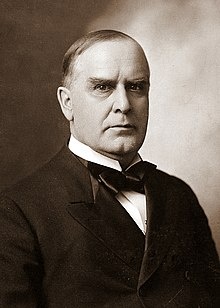
#40 Street Car Begins Service to San Mateo
1902-12-31
% complete
The interurban #40 streetcar right-of-way land ran parallel to and west of the Southern Pacific Railroad through most of the cities in San Mateo County. The new owners resold the line in 1901 and it was renamed the United Railroads of San Francisco. To fulfill the terms of the franchise, a single track was opened to San Mateo on Dec. 31, 1902. A power station to supply electricity for the line was built near the S.P. tracks at Millbrae Avenue.
Pictured: Rail line in 1904 approaching Tanforan.
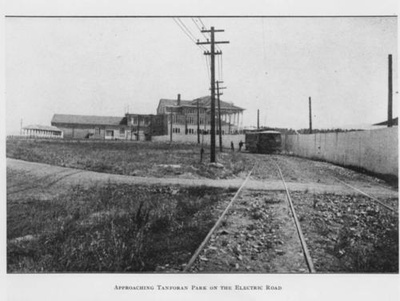
P. J. Sullivan Dry Goods Opens
1905-01-01
% complete
P. J. Sullivan ran a grocery store at Kains and San Mateo Aves and served as a notary public. He was a well-known figure in the community, but not always well-liked. In 1909, P. J. Sullivan was accused of setting fire to the DeBenedetti Brothers' store, another grocery store on San Mateo Ave.
Pictured: "Looking east from 677 Masson toward P. J. Sullivan's store at Kains and San Mateo Aves. Early 1920s." The young women are Teresa (back center) and Mary (left) Beltramo, Marjorie Hollet (in hat) and Julia Della Maggiora (right).
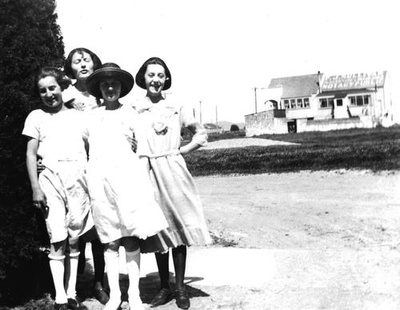
Post-Earthquake Migration to San Bruno
1906-04-18
% complete
Early in the morning of April 18, a massive earthquake shook San Francisco. The damage from the quake and the resulting fire left half of the city's 400,000 residents homeless. Many of the city's refugees moved down the Peninsula, setting up tent cities with the aid of the communities that would become San Bruno, South San Francisco and Colma, among others. As reconstruction continued, many San Franciscans elected to stay in San Bruno and the surrounding communities, greatly increasing San Bruno's population and contributing to its first "housing boom."
Pictured: Devastation after the earthquake
The Evacuation of San Francisco
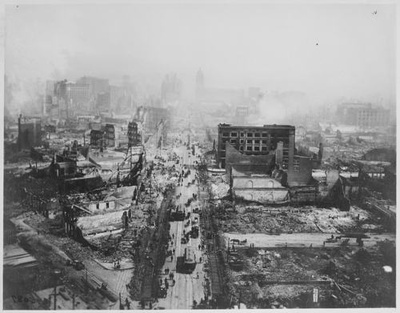
Post Earthquake Businesses Open
1906-10-01
% complete
Following the 1906 earthquake many people moved to the unincorporated San Bruno area from San Francisco. LoReaux plumbing was probably the first business to begin in the area, in a building at 678 San Mateo Ave. Around the same time, Sebastiani Della Maggiora purchased a site south of the burned-down San Bruno House and built a grocery and wine store at 733 San Mateo Ave. Other general stores were opened by P. J. Sullivan and the DeBenedetti famliy.
Pictured: DeBenedetti Market, 1914
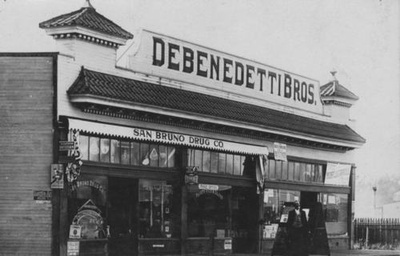
Old Tin Schoolhouse Built
1907-02-22
% complete
Located at 744 El Camino Real, this was the first school in San Bruno and its first principal was Mrs. E. Loomis. The building quickly proved too small for use as a schoolhouse, so it served as the seat of San Bruno government from 1915 until the dedication of the new City Hall in 1953.
"Built by volunteer labor, this two-room school became the site of San Bruno's first City Hall in 1915. The building had tin-plate siding pressed to look like bricks, hence the name "Old Tin Schoolhouse".
Darold Fredricks, San Bruno People and Places
Pictured: "Old Tin Schoolhouse" (San Bruno Park School), c. 1906-1910
Class Portrait Taken on the Steps of the "Old Tin Schoolhouse", c. 1906-1908
Excerpt of an Interview with Longtime San Bruno Resident, George Jenevein - Old Tin Schoolhouse
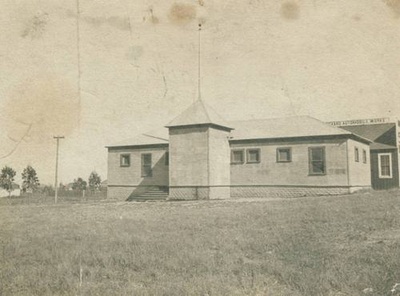
Construction Begins on St. Bruno's Church
1908-11-13
% complete
St. Bruno's Church, originally located on the corner of Hensley and San Bruno Avenues, was built by volunteer church members who, up until that point, had been meeting in Cody Hall on Mills Ave. St. Bruno's was the first Catholic church in the area and became a parish church in 1912.
Pictured: Original St. Bruno's Church
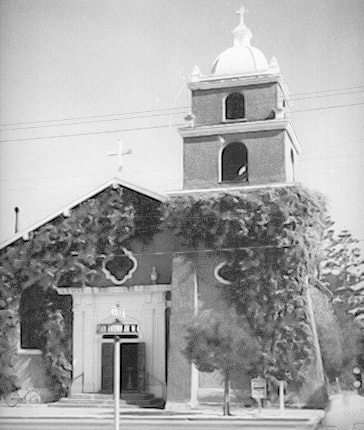
Formation of San Bruno's Volunteer Fire Department
1909-01-02
% complete
With the increased development of San Bruno, some form of fire protection became necessary, and the first volunteer fire department was formed in 1909. Firefighting was so popular, and the community response so enthusiastic, that over a hundred men volunteered for the department. This large group proved to be unwieldy (volunteers tended to get in each others' ways instead of putting out fires) and the number of volunteers was restricted.
Gus Magnuson was the unofficial leader of the volunteer firefighters from 1909 until 1917, when an official fire department was created and Harry Loose appointed fire chief.
Pictured: San Bruno Volunteer Fire Company, Admission Day Parade, September 9, 1914
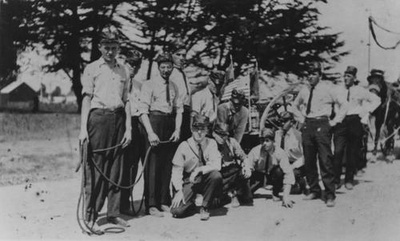
Walker-Otis Bill Outlaws Horse Racing
1909-02-05
% complete
Once the Walker-Otis bill became law, all gambling was banned from racetracks, removing one of the major attractions of horse racing and one of the racetracks' major sources of revenue. Horse racing at Tanforan Racetrack ceased until 1923 and other uses were found for the track.
Novelty Theater Opens
1910-01-01
% complete
The Novelty Theatre was built around 1910 at the intersection of San Mateo and Taylor Avenues. It was originally operated by George Roy, a partner in the San Bruno Lumber Co. In 1921, it was charging 20 cents per show. It was torn down later in that decade and replaced by the El Camino Theatre, which operated until the 1970's, when it was remodeled and became a home for various businesses.
Peninsula Heritage, Elias Castillo, San Francisco Examiner, Friday, June 23, 1995
Pictured: Novelty Theatre
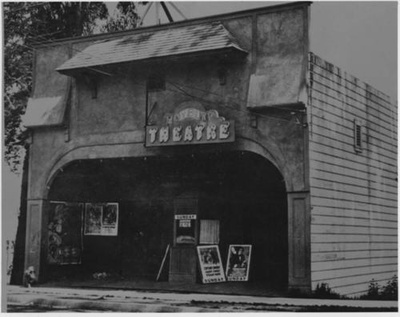
First Airplane Flight in the Bay Area
1910-01-24
% complete
Louis Palhaun pilots first airplane flight in the Bay Area from Tanforan, January 24, 1910.
"San Francisco has seen a man fly," breathlessly wrote the correspondent of the San Francisco Call, then he continued: "The spectacle was witnessed by a throng that had waited through two days of wind and rain with unequaled patience for this unequaled sight. The unanimous opinion was that patience never reaped a fatter fee."
"The brave little Frenchman flew for 8 minutes, going 8 miles - 60 miles an hour - and rose to an altitude of 700 feet, skirting the range of hills to the west of Tanforan, and at times passing out of sight of the thousands at the aviation field."
San Mateo County Historical Association, La Peninsula, May 1953
Pictured: Louis Palhaun pilots first airplane flight in San Mateo County from Tanforan, January 24, 1910
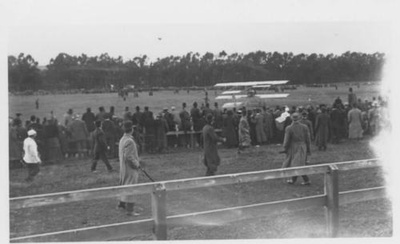
Green's Hall Built
1910-07-02
% complete
"A large, two-story wooden structure was built at 422 San Mateo Ave in the early 1900s by A. Hyde Green...This large building was used as a dance hall, a movie theater, and an all around community meeting hall. the first bank in San Bruno the California Bank of San Mateo County, was begun in the front of the hall...The bank later affiliated with Bank of Italy, which, in turn, became Bank of America.
After incorporation in 1914, the San Bruno City Council used the hall for its first official meeting place. The Incorporation Dance was held here, though the celebration used San Mateo Ave and El Camino Real as well."
Darold E. Fredricks, San Bruno History Index, vol. 2
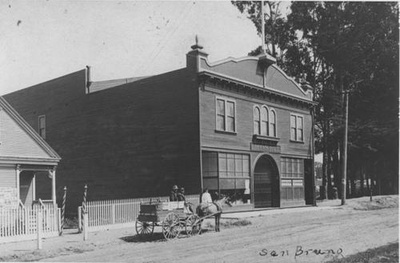
First Successful Airplane Landing on a Ship
1911-01-18
% complete
Eugene Burton Ely takes off from Tanforan Race Track and lands on the armored cruiser, USS Pennsylvania, anchored in San Francisco Bay. This flight signaled the beginning of naval aviation.
Pictured: Eugene Burton Ely
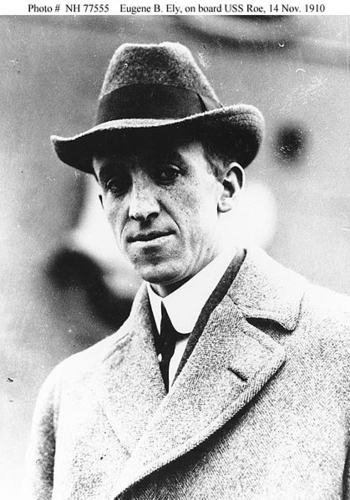
Groundbreaking of El Camino Real
1912-08-07
% complete
Groundbreaking ceremony for State Highway 1, the first paved highway to be constructed in California since the creation of the California Highway Commission. The Commission is represented by Chairman Towne, the man in the center with the shovel.
To celebrate the ground breaking, a huge party and picnic was held at Uncle Tom's Cabin.
"The celebration lasted all day with overflow crowds eating beans and barbecued steak in the adjoining city park along El Camino Real."
Darold Fredricks, Images of America: San Bruno
Pictured: Groundbreaking ceremony for State Highway #1, San Bruno, August 1912
Ladies Serving Lunch at Groundbreaking for the Paving of El Camino Real, 1912
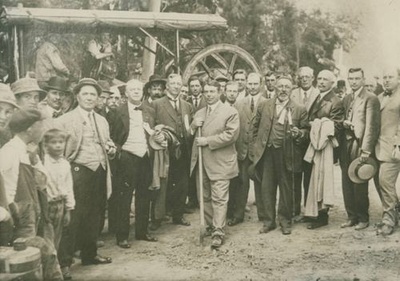
Admission Day Parade
1912-09-09
% complete
The Admission Day Parade was an annual event celebrating California's admission to the U.S. as a state on September 9, 1850. San Bruno residents were proud of their state, and this festive parade continued to make its way through San Bruno streets into the 1930s.
Pictured: Participants in San Bruno's Admission Day Parade, c. 1912. (Man in center wearing dark suit is Nicholas Dresher, owner of N.D. Hall)
Part of the Admission Day Parade, 1922
San Bruno Admission Day Celebration Official Program, September 8-10, 1923
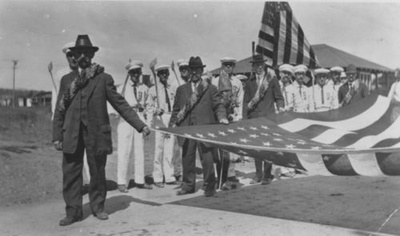
San Bruno Herald Begins Operations
1914-07-02
% complete
The San Bruno Herald was an independent newspaper published once a week on Thursday mornings and eagerly awaited by San Bruno residents. It ran from 1914 to the 1990s. The Herald headquarters started at 624 San Mateo Ave, next to the Volunteer Fire Department, and moved twice: first to the corner of Angus and Mastick Avenues, then to a larger building in South San Francisco.
Pictured: San Bruno Herald building at 624 San Mateo Ave, c. 1940
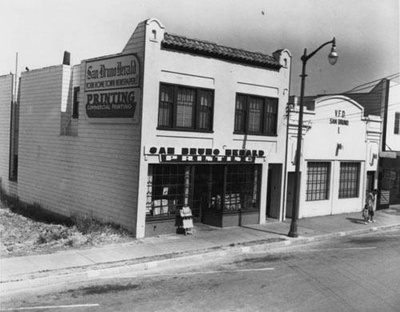
San Bruno Charter Celebration Day
1914-09-05
% complete
San Bruno celebrates the creation of the City Charter. The City became officially incorporated three months later on December 23, 1914.
As part of the celebrations, which included a parade and a dance, San Bruno residents elected a Queen of the parade. Edith Schmidt Cook was voted Queen and she chose Harry Cook as her king. They were married a year later.
Edith's family, the Schmidts, moved to San Bruno in 1907 and ran the Schmidt Meat Market until the 1950s. Edith met Harry while helping the market's butcher boy make deliveries.
Boy Scout Troop 72 Formed
1916-11-02
% complete
San Bruno's Boy Scout Troop 72 was formed in November 1916, not long after the Boy Scouts of America was founded in 1910. The troop was chartered at San Bruno United Methodist Church, and one of its charter members, Ralph Halliday, later became the troop leader. It is one of the longest running Boy Scout Troops in the Bay Area.
Pictured: Troop 72 with a plaque commemorating the US Bicentennial in front of the United Methodist Church, June 1976
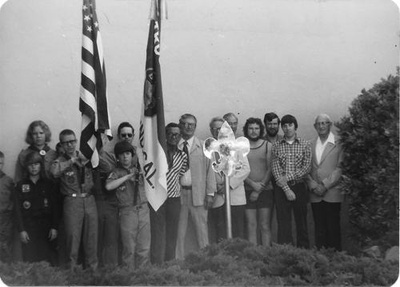
California Troops Train for WWI
1917-08-10
% complete
Training begins for the California "Grizzlies,"a regiment of the 144th Field Artillery of the US Army, at Tanforan Race Track. The "Grizzlies" served in Europe during the First World War, and returned from the Western Front on January 18, 1919.
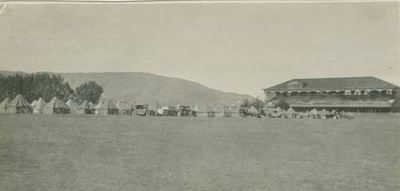
Violinist Ruggiero Ricci Born
1918-07-24
% complete
Ruggiero Ricci (b. July 24, 1918 - d. Aug. 6, 2012) was born to a musical Italian family in San Bruno and originally named Roger Rich. Ruggiero's father began teaching him violin at age 7. He soon gained a reputation as a child prodigy and gave his first public performance in San Francisco in 1928. His siblings were similarly talented: his brother George Ricci was a famous cellist and his sister Emma played violin with the New York Metropolitan Opera.
Ruggiero Ricci played violin all of his life. After receiving international training in his youth, he served in the US Army as an entertainer during WWII. He went on to perform in more than 6,000 concerts and make more than 500 recordings over his 70 year career. In addition to his own performances, he taught violin at several universities in the US and Europe, including Julliard and the University Mozarteum in Austria.
Pictured: Ruggiero Ricci at age 11, playing at the Berlin Philharmonie in Germany
Remembering Ruggiero Ricci: A Virtuoso Soloist Spurred By Army Service
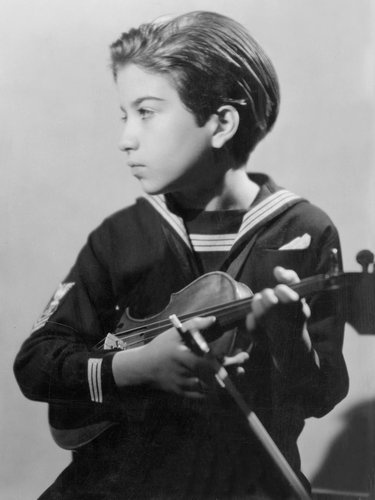
Prohibtion: The 18th Amendent Bans Alcohol
1920-01-17
% complete
From 1920 to 1933, when the 18th Amendment was repealed, the production, sale and transportation of alcohol was banned in the United States. While Prohibition did reduce the consumption of alcohol, it also resulted in a underground network of speakeasies, illegal stills, rum-runners, and criminal syndicates.
Pictured: Prohibition agents destroying barrels of alcohol, 1921
Policeman standing alongside wrecked car and cases of moonshine liquor, 1922
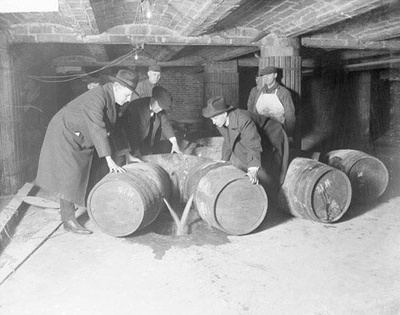
Joe's Pool Parlor Opens
1921-02-27
% complete
Joseph Sammut opened his pool parlor at 678 San Mateo Ave, the former site of Al LoReaux's plumbing shop, in 1921. The pool parlor was also equipped with a telephone exchange, where Joe's employees would take calls and cover bets mostly concerning the horse races at Tanforan. The pool parlor and bookmaking operation continued for many years, including during San Francisco's ban on bookmaking in the 1940's. Eventually Joe's Pool Parlor became Artichoke Joe's.
"Joe accepted any wager, no matter how large. When asked how he would pay off if he lost a big bet, he replied, 'In artichoke leaves,' hence the name."
Artichoke Joe's remains in operation to this day.
Pictured: George Martinelli in Osborne's gasoline station the northwest corner of Kains and San Mateo Avenues, with Joe's Pool Parlor in the background, c. 1930
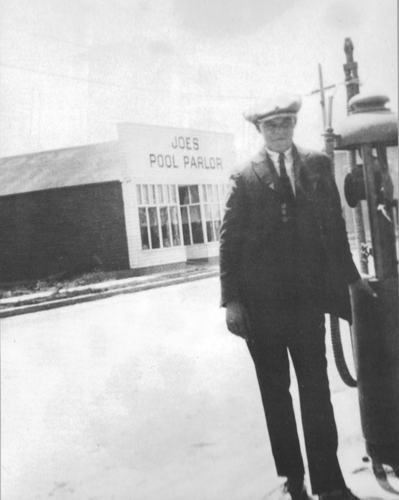
Joshua Maule Opens Maule's Drugs
1922-07-01
% complete
Joshua Maule opened his drugstore and soda fountain at 551 San Mateo Ave, the former site of Schmidt's Meat Market in 1922. The family-owned business operated in additional locations on San Mateo Ave, but closed for business in 1972.
Pictured: Maule's Drugs, San Mateo Ave, 1940s
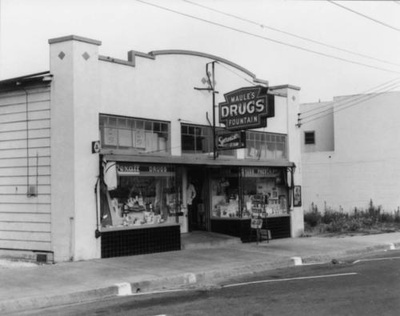
Tanforan Racetrack Reopens
1923-11-03
% complete
With horse racing again legal in California, Tanforan reopens as a race track to great fanfare, with newly constructed stands and clubhouse. Horseracing had stopped at Tanforan in 1908 when California outlawed betting at race tracks and during WWI it had served as a training camp for the "Grizzlies," a U.S. Army unit.
Pictured: Tanforan Race Track
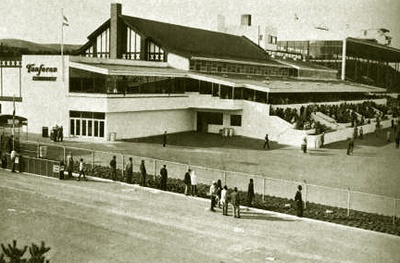
Opening of Mills Field Municipal Airport
1927-05-07
% complete
Dedication and opening of Mills Field Municipal Airport, which would be renamed San Francisco Municipal Airport in 1931 and San Francisco International Airport in 1955.
Pictured: Mills Field Municipal Airport, January 1927
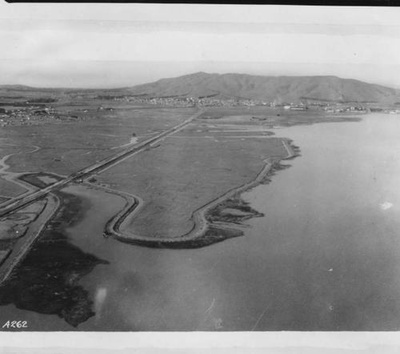
Charles Lindbergh Arrives at Mills Field Airport
1927-09-16
% complete
Lindbergh and the "Spirit of St. Louis" landed at Mills Field for "Lindbergh Day," a celebration in honor of his trans-Atlantic flight in May of that year. He was met at the field by an excited crowd and a parade of dignitaries, including San Francisco Mayor James "Sunny Jim" Rolph, Jr.
Charles Lindbergh was involved for several years in the development of Mills Field. His efforts helped bring the first commercial airline services to a field primarily known for its stunt fliers.
Pictured: Arrival of Charles Lindbergh and the "Spirit of St. Louis" at Mills Field Municipal Airport, September 16, 1927
Charles Lindbergh and James Rolph Jr., in a Parade from Mills Field, September 16, 1927
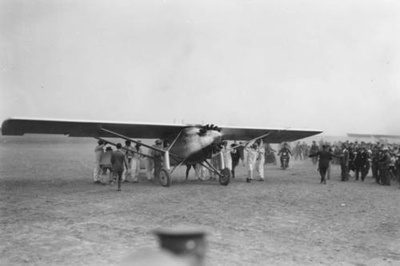
Athlete Ann Cavello Born
1929-08-02
% complete
Ann Calvello (August 1, 1929 - March 14, 2006) was a U.S. athlete and roller derby queen. She grew up in the Bay Area and graduated from Presentation High School in San Francisco in 1947.
Calvello competed in roller derby from the 1940s through the 2000s. She competed all over the United States and traveled internationally to compete. In 1968, she was inducted to the Roller Derby Hall of Fame. Calvello moved back to the Bay Area and spent the last years of her life living in San Bruno.
Pictured: Ann Calvello competing in roller derby. Courtesy of Harry Costa.
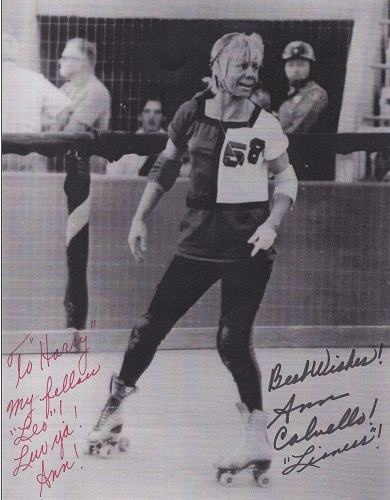
The Great Depression
1929-10-29
% complete
The stock market crash of October 1929 sparked a global depression that had a devastating effect on most of the Western world. The American economy was in particularly bad condition, with the droughts and dust storms of the Dust Bowl adding to the problems caused by the stock market collapse.
When the Depression reached its height in 1933, "some 13 to 15 million Americans were unemployed and nearly half of the country’s banks had failed. Though the relief and reform measures put into place by President Franklin D. Roosevelt helped lessen the worst effects of the Great Depression in the 1930s, the economy would not fully turn around until after 1939, when World War II kicked American industry into high gear."
History Channel, "The Great Depression"
Pictured: Bread line at kitchen, 4th and Jefferson Streets, Oakland, Feb. 1934
Destitute Man Leaning Against Vacant Store, by Dorothea Lange, 1935
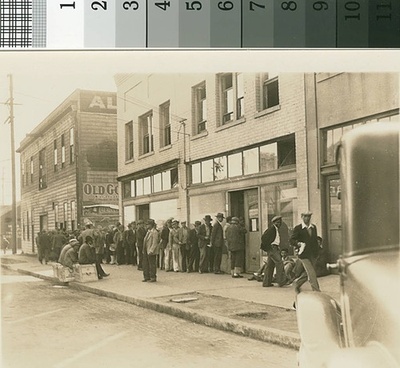
El Camino Theater Opens
1930-07-01
% complete
The El Camino Theater, which sat at the intersection of San Mateo Ave and El Camino Real, was the largest building in San Bruno when it opened in July 1930. The theater was one of the most popular entertainment centers on the Peninsula, and remained a centerpiece of the community until it closed in the early 1970s.
Pictured: San Bruno residents have taken over the theater and provided their own marquee. The theater was showing "Sons of the Legion, " which came out in 1938.
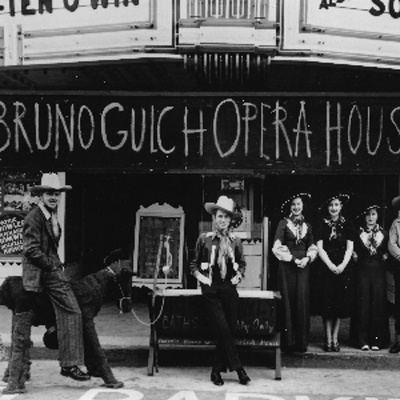
Baseball in San Bruno
1933-07-02
% complete
Baseball was and remains a popular pastime in San Bruno, played by children and adult teams alike. The baseball team pictured here was sponsored by San Bruno merchants. The game to the right is being played at San Bruno Park. The diamond there was constructed in the 1940s and renamed Tom Lara Field in 1988, in honor of coach Tom Lara, who had served as San Bruno Parks and Recreation Commissioner for more than 20 years.
Pictured: San Bruno Baseball Team, c. 1940
Baseball Game in San Bruno Park, May 4, 1941. Taken by Fred Beltramo.
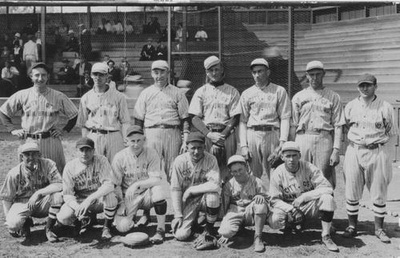
Eimac Corporation Founded
1934-01-01
% complete
While employed by the small San Francisco, California manufacturing firm of Heintz & Kaufmann, Bill Eitel and Jack McCullough convinced company president Ralph Heintz to allow them to develop a transmitting tube that could operate at lower voltages than those then available to the amateur radio market, such as the RCA 204A or the 852. Their effort was a success and resulted in production of the HK-354. Shortly after in 1934, Eitel and McCullough left H&K to form Eitel McCullough Corp. or Eimac in San Bruno.
Pictured: W. W. Eitel (left), President and J. A. McCullough, Executive Vice President, co-founders of Eimac in 1934, are shown in front of a new 150,000 square foot manufacturing plant
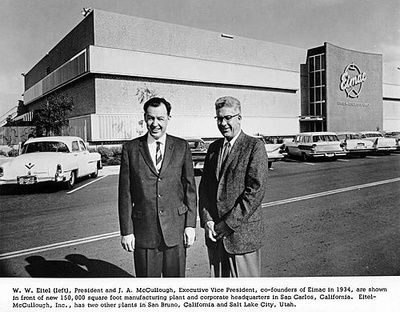
Carlton Corners: The Girl Scout House
1936-07-02
% complete
Grace Baker founded San Bruno's Girl Scout troop in 1936, and worked to build what came to be known as the Girl Scout House at 290 Carlton Ave, the tip of San Bruno's "heart."
"...A group of volunteers headed by Mrs. Grace Baker, solicited labor, donations, building materials and money to construct a building for the girl scouts. San Bruno officials donated the Carlton Ave. lot for the project."
The building became a permanent meeting place for the Girl Scouts, who used it until 1952 when they joined the national federation. The Girl Scout House was then deeded back to the City of San Bruno, and run by the Carlton Corners Association, which took its name from the house's new moniker. Carlton Corners was, and continues to be a meeting place for boy and girl scouts, the 4H club and numerous other organizations.
Helen Sierra, More Than a Home, 1970
Pictured: Girl Scouts at the dedication of Carlton Corners as the Girl Scout House. From left to right: Mary Jean Mayer, Carol Hughes, Pat Cocanaugher, last girl unknown. Courtesy of Bernice Cook Roberts.
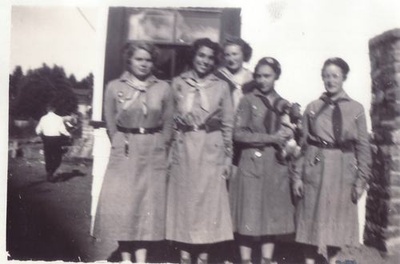
Dedication of First Permanent City Library
1939-06-24
% complete
Dedication of the first permanent city library, located on Jenevein Ave between San Mateo Ave and El Camino. This library remained in operation until 1955, at which time it had a collection of 25,000 books. It was closed when plans for a larger library became part of the proposed plan for a new city hall complex on Angus Ave.
Pictured: San Bruno Public Library, c. 1926. Mrs. Sarah Bellamy's notions store at 549 Easton Ave was home to the San Bruno Library from 1926 to 1937.
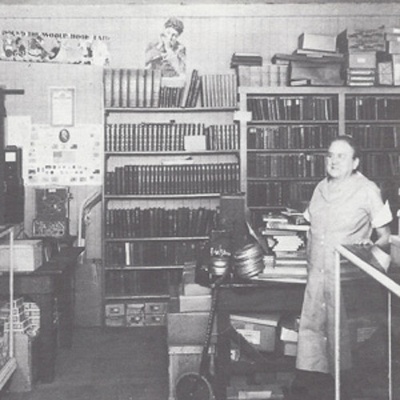
Seabiscuit Races at Tanforan
1939-10-24
% complete
Seabiscuit, a champion Thoroughbred, trained at Tanforan Race Track after recovering from an injury sustained while racing. A statue of Seabiscuit now sits in front of the Shops at Tanforan.
Pictured: Seabiscuit and Red Pollard, between 1936 and 1940
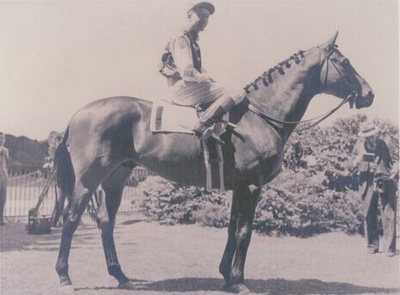
Creation of San Bruno Park
1940-02-01
% complete
The City of San Bruno buys 23 acres from the Mills Estate along Crystal Springs Road for use as a city park. As the city grew, several additions were made to the park, including a pool, a recreation center, and a baseball diamond.
First Posy Parade Held
1941-06-01
% complete
First Posy Parade held as part of a youth program, with 80 boys and girls taking part. The Posy Parade began as a "festival of flowers" dedicated to children, who would decorate floats, bicycles, wagons and carriages with flowers and parade down San Mateo Ave. Prior to the first parade, the City held an Admission Day Parade in September. The Posy Parade superseded this event and was moved in 1941 to the first Sunday in June each year. It has been held almost every year since. At its height in the 1960s, the parade attracted as many as 3 thousand participants and 20 to 30 thousand spectators.
Pictured: Posy Parade participants Barbara Elston Dowd and Cathy Dowd McGrew on San Mateo Ave, c. 1954.
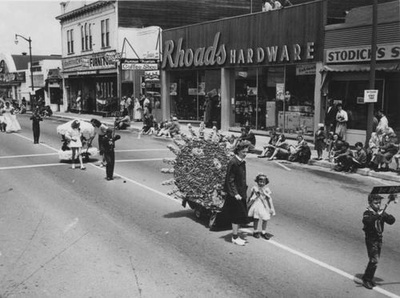
Bombing of Pearl Harbor
1941-12-07
% complete
Japan attacks Pearl Harbor and US enters WWII. San Bruno saw an increase in population and industry as civilians and soldiers gathered in the Bay Area. 16,000 soldiers were stationed in or passed through San Bruno. The Eimac plant in San Bruno began to produce vacuum tubes for the US military for use in radar equipment. Tanforan Race Track became a temporary Assembly Center for Japanese Americans and later a naval base.
Japanese Americans Arrive at Tanforan
1942-05-01
% complete
After the attack on Pearl Harbor on December 7, 1941. President Roosevelt signed Executive Order 9066, which authorized the relocation and internment of American citizens of Japanese ancestry and resident aliens from Japan. In March 1942, General de Witt, Commander in Charge of the Western Defense Area, issued orders to evacuate all persons of Japanese ancestry from the Pacific coast. The evacuation took place in two stages: first to temporary Assembly Centers, including Tanforan, and then to more permanent internment camps.
Tanforan served as the Assembly Center for northern California, and 3,112 Japanese Americans arrived in May 1942. The internees stayed in barracks and whitewashed horse stalls, and they were only able to bring what they could fit in a suitcase. Tanforan housed 7,700 internees over the 7 months it served as an Assembly Center. Once they left Tanforan, the Japanese Americans were sent to permanent camps further east, including Topaz, Manzanar and Heart Mountain.
Pictured: Evacuees of Japaneses ancestry arriving at the Tanforan Assembly center. Taken by Dorothea Lange.
Internment of Japanese Americans
Japanese Relocation and Internment
HD Stock Footage WWII Japanese Relocation by Order of the President
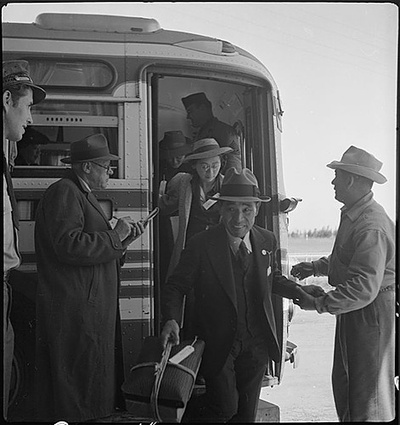
Dedication of Golden Gate National Cemetery
1942-05-30
% complete
Official dedication of Golden Gate National Cemetery. The land had been purchased by the War Department in 1938 and the first interment occurred in 1941. The cemetery is the final resting place of soldiers from every US war and military action since the 1890s, including Admiral Chester W. Nimitz and several Medal of Honor recipients.
The cemetery occupies 161 acres bordered by Sneath Ln and El Camino Real.
Pictured: Golden Gate National Cemetery. Photograph courtesy of Harry Costa.
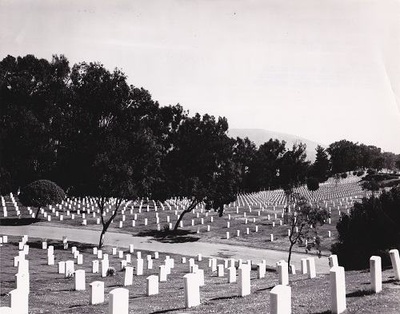
San Bruno USO Club Opens
1942-07-01
% complete
The USO Club, called the Hospitality House, catered to locally stationed and returning US troops. It was open from July 1942 to January 1946. The Club was located at the old school on Elm Ave (currently the San Bruno Park School District offices) and run by Mrs. Helen Pinkerton.
Pictured: USO Club Advertisement
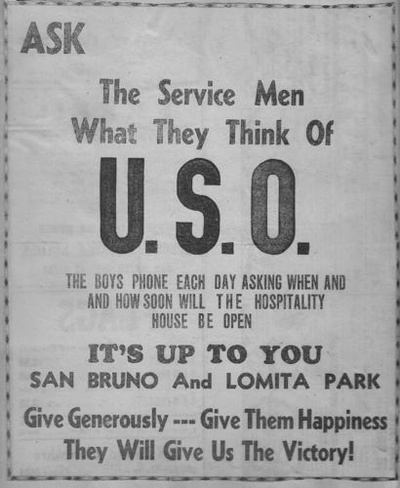
Opera Singer Luana DeVol Born
1943-07-01
% complete
Operatic soprano Luana DeVol was born in San Mateo in 1943, grew up in San Bruno and graduated from Capuchino High School. An early interest in music led her to study violin and singing. She became involved in theater while at the College of San Mateo, and was able to continue her vocal studies in London.
Beginning in the mid-1980s, Luana DeVol performed in numerous concerts and operas in the San Francisco Bay Area and later in Europe, particularly in Germany. In 1997 and 2000, she was named "Singer of the Year" by the German opera magazine Opernwelt. She returned to the United States in 2006 to make her debut at the Metropolitan Opera, and she continues to be active in the opera community, both teaching and performing.
Wagner: TANNHÄUSER - Arie "Dich, teure Hall, ..." - Luana DeVol
Pitcher Wally Bunker Born
1945-01-25
% complete
Wallace Edward Bunker, a former Major League Baseball pitcher, was born in Seattle in 1945 and pitched for the Capuchino High School varsity baseball team in 1962 and 1963. He played for the Baltimore Orioles from 1963 to 1968 and for the Kansas City Royals from 1969 to 1971.
In 1964 he was named American League Rookie Pitcher of the Year and his pitching brought the Orioles near to winning the American League pennant.
After a shoulder injury forced him out of baseball at age 26, Wally Bunker turned to the arts, learning painting, pottery and the piano, and more recently, writing children books with his wife, Kathy Bunker.
Ron "Pigpen" McKernan Born
1945-09-08
% complete
Ronald "Pigpen" McKernan, founding member of the Grateful Dead, was born in San Bruno and grew up in the Bay Area. His father was a R&B and blues disk jockey, and Ron was interested in music from an early age. He taught himself to play blues piano and harmonica. When he met Jerry Garcia in the early 1960s, they began to play frequently together, eventually collaborating in the predecessor groups to the Grateful Dead.
When the Grateful Dead came together in 1965, Ron played keyboard and harmonica, as well as contributing vocals. He was also responsible for adding many signature songs to the band's repertoire, including "Turn on Your Lovelight" and "In the Midnight Hour."
Ron McKernan passed away in March 1973, at age 27, from cirrhosis.
Pictured: Ron "Pigpen" McKernan
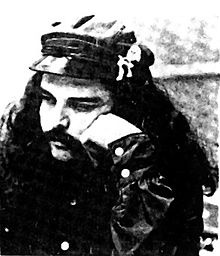
Suzanne Somers Born
1946-10-16
% complete
Suzanne Somers is an American actress, author, singer and businesswoman. Born Suzanne Marie Mahoney, she grew up in San Bruno and attended Capuchino High School.
She started acting in small roles in the 1960s and 1970s before landing the role of "Chrissy Snow" on Three's Company in 1977. Somers is particularly well-known for her work on infomercials, and she was the official spokesperson for the Thighmaster in the 1980s. In addition to her work in film and television, which she has continued to recent years, Somers is also the author of a series of best-selling self-help books.
Pictured: Suzanne Somers
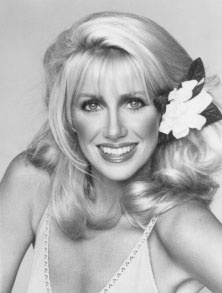
#40 Streetcar Ceases Operations
1949-01-15
% complete
The #40 streetcar line, which ran from San Francisco to San Mateo for nearly 50 years, ceases operations.
Pictured: Streetcar on the #40 line, with sign advertising service to San Bruno, Daly City and the Colma Cemeteries, ca. 1940s
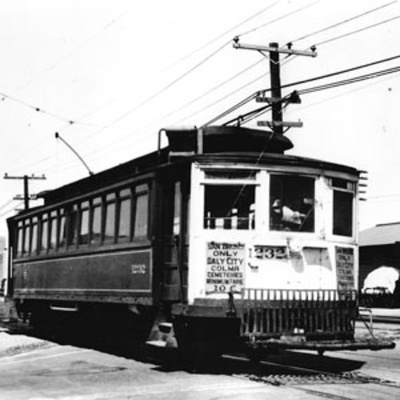
Fire at Lucky Supermarket
1949-06-30
% complete
The Lucky Supermarket was located at Crystal Springs and El Camino Real, on the former site of Uncle Tom's Cabin. It was destroyed by an accidental fire in 1949, the largest fire loss San Bruno had seen to that point.
Pictured: Aftermath of the fire.
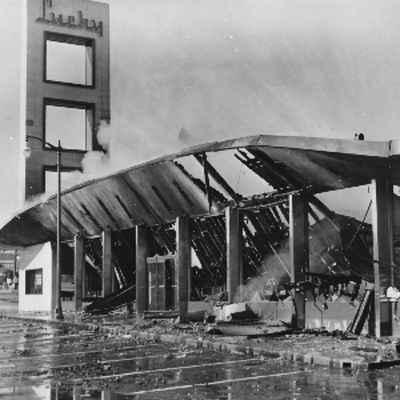
Capuchino High School Opens
1950-09-11
% complete
Capuchino High School opens to first freshman class. Max Russell served as principal from the school's opening until 1954. Capuchino was the first high school in San Bruno, built to accommodate the city's growing student population.
Before Capuchino was built, San Bruno teenagers went to Burlingame or San Mateo High Schools, taking special cars on the #40 streetcar line.
San Bruno's second high school, Crestmoor, opened on September 5, 1962. The school was closed in 1980, due to declining enrollment, and its student body merged with Capuchino.
United Nations Day
1950-10-21
% complete
United Nations Day is celebrated in San Bruno for the first time. This day marks the anniversary of the founding of the United Nations, and the signing of its charter in San Francisco in 1945. San Bruno's second mayor, A. S. W. Grundy, started the tradition of celebrating United Nations Day in San Bruno, a tradition which continued for many years.
New City Hall Opens
1953-09-19
% complete
Dedication of the new City Hall at 567 El Camino Real. Up until that time, the "Old Tin School House" on El Camino Real had served as the Town Hall.
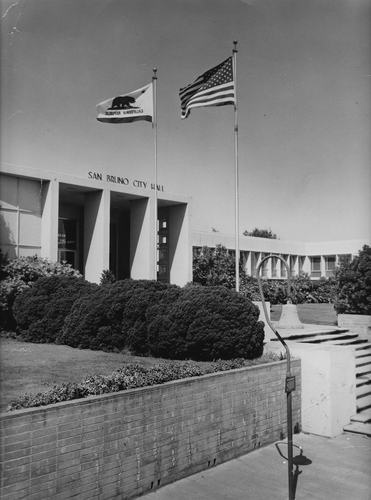
Lomita Park Becomes Part of San Bruno
1954-01-01
% complete
Lomita Park, California was a small unincorporated community adjacent to San Bruno in San Mateo County, just west of the San Francisco International Airport. It was roughly bounded by San Felipe Avenue, El Camino Real, San Juan Ave, and the Southern Pacific railroad tracks. In 1953, San Bruno annexed the community. Lomita Park had its own Southern Pacific train station and some community services, including a volunteer fire department and a post office. The community still is identified as the "Lomita Park district" of San Bruno.
Parkside Intermediate School Opens
1954-01-01
% complete
Parkside Intermediate sits on Niles and Donner Avenues, near St. Robert's Church. The public schools is attended by 6th, 7th and 8th grade students in the San Bruno Park School District.
SFO Flight Festival & Terminal Dedication
1954-08-27
% complete
Dedication of San Francisco International's new Central Passenger Terminal, now Terminal 2.
"The dedication ceremony for the new terminal kicked off a three-day celebration. Forty-three aircraft were exhibited on the airfield for crowds numbering in the hundreds of thousands. The festival program included air shows, flying tours, and demonstrations of the latest jet engine technology."
Dedication of New San Francisco International Airport Terminal Building
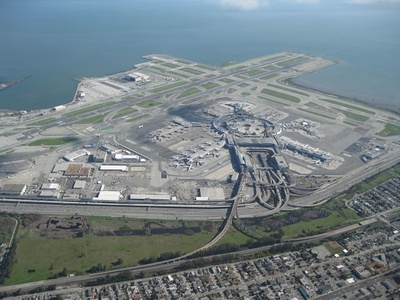
Dedication of the War Memorial Recreation Center
1956-06-01
% complete
Dedication of the first section of the War Memorial Recreation Center, now known as the Veterans' Memorial Recreation Center, in the City Park.
In 1945, need for a larger communal space combined with a desire to recognize and memorialize the men and women who had fought for the United States in WWII. After a years-long fundraising campaign led by San Bruno residents, the Recreation Center was built and the first section dedicated in 1956.
Pictured: The second section of the Recreation Center under construction, January 1958. Courtesy of Harry Costa.
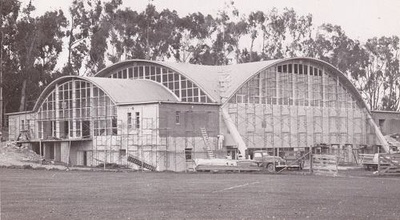
Dedication of St. Robert's Church
1957-12-07
% complete
Dedication of St. Robert's Catholic Church, located at Crystal Springs and Oak. St. Robert's was built to satisfy the needs of a parish that grown too large for St. Bruno's. A Catholic school had been built to the north of the church in 1949.
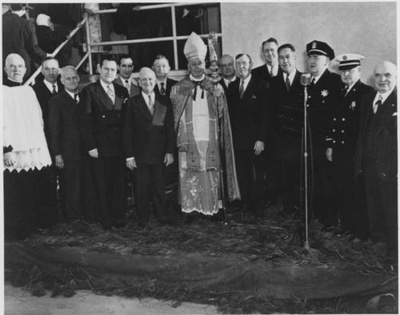
Dedication of the Central Fire Station
1959-07-01
% complete
Dedication of the Central Fire Station at the Civic Center Complex on El Camino Real. This fire station met the needs of a larger fire department and replaced the previous fire station at the junction of Huntington and San Mateo Avenues.
Pictured: Central Fire Station. Picture courtesy of Harry Costa.
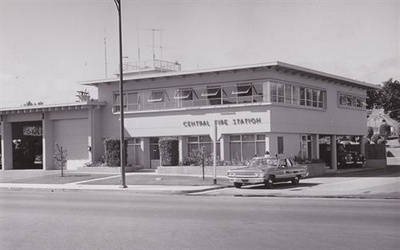
New St. Bruno's Church Opens
1960-12-01
% complete
The old St. Bruno's had been serving the city's Catholic community since 1908, but the increased size of the congregation and the age of the building led to it being torn down in 1960. The last mass celebrated in the old church was held on December 24, 1959, and a new building was built on the corner of Green Ave and San Bruno Ave.
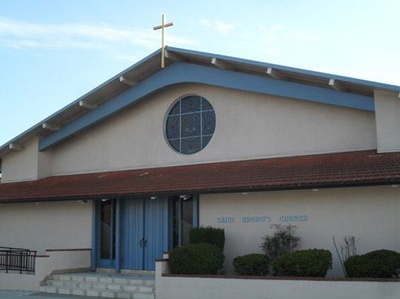
Snow in San Bruno
1962-01-21
% complete
A rare 1.5 inches of snow fell on San Bruno early in 1962.
Pictured: Children playing the in the snow on Claremont Drive. Courtesy of Emil Hons.
Dedication of the Mission Bell
1963-02-22
% complete
Dedication of the Mission Bell that stands in front of City Hall by the Anne Hutchinson Chapter of the Colonial Dames. The Mission Bells were once located up and down the California Coast to mark El Camino Real and the path between the California Missions.
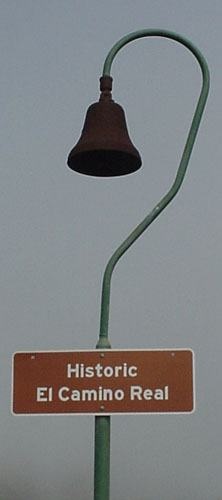
San Bruno's 50th Anniversary
1964-01-01
% complete
San Bruno celebrates the 50th anniversary of its incorporation as a city.
Pictured: City of San Bruno 50th Celebration
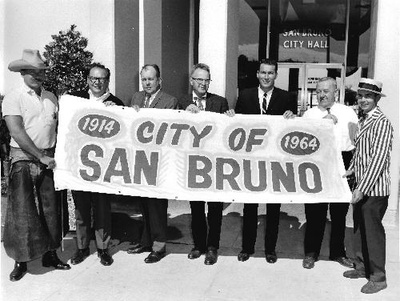
Dedication of Pacific Heights Park
1964-04-05
% complete
In 1964, the City of San Bruno dedicated 5 acres of undeveloped land between Longview and Goodwin Drives as a public park. Eventually landscaping, a baseball field, outdoor basketball court, a walking path and a children's play area were constructed.
Darold Fredricks, San Bruno History Index, vol. 2
Pictured: Group of officials at dedication of Pacific Heights Park, 1964

Fire at Tanforan Racetrack
1964-07-31
% complete
A fire destroys Tanforan Race Track. The track had been in operation since 1899, serving as race track, training camp and assembly center over its 65 year history. The site is currently the home of the Shops at Tanforan.
Pictured: Aftermath of the Tanforan fire
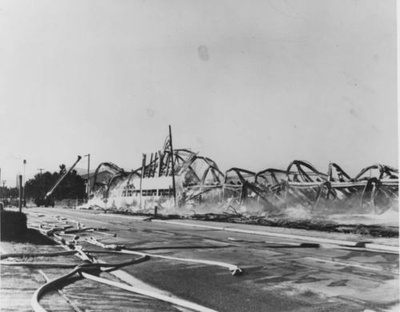
Discovery of Ohlone Village Site Near I-280
1968-07-04
% complete
Archaeological excavation of Ohlone village begun around Sneath Lane and I-280. The construction of I-280 had uncovered traces of the Ohlone village, which were spotted by Emil Hons, then senior at Crestmoor High School.
The area had once been inhabited by members of the Ohlone tribe, who lived in the coastal regions of California before the arrival of the Spanish.
Pictured: "Ohlone Indians in a Tule Boat in the San Francisco Bay 1822," by Louis Choris
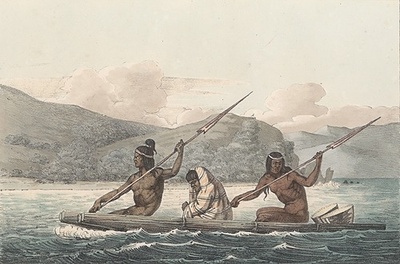
4-H Farm Built
1969-07-01
% complete
San Bruno 4-H Club established and its farm built with the help of Jeanne French. The 4-H farm was built on 1st Ave, on land donated by the San Bruno Park School District and San Francisco International Airport. The farm buildings were built with supplies and labor donated by the local community and organized by Jeanne French, who also helped start the San Bruno Community Gardens.
The San Bruno 4-H farm was one of the first in the US where city children could own and raise animals. The 4-H Club remains active, though its members participate in many projects in addition to raising animals. The Club is currently made up of children from South San Francisco as well as San Bruno.
Pictured: 4-Hers tend to their sheep, 1974. The San Brunan, vol. 2 n. 2
Excerpt from an interview with San Brunan, Rose Hasha. Recorded in 2014 - Growing Up in 4-H
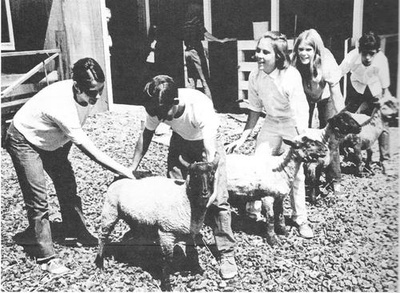
I-380 Constuction Begins
1970-05-01
% complete
I-380 was intended to connect Highway 101 with I-280 and extend to Highway 1 along the coast. During the late 1960s, I-280 was under construction and the state began making preparations for I-380, buying land in Crestmoor Canyon along the interstate's projected route to Pacifica.
Construction began on I-380 in mid-1970, against the protests of the communities along the route. Opposition mounted through October 1975, when CalTrans, reacting to active community protests, recommended that the I-380 extension be eliminated. In June 1976, the California government officially "unadopted" I-380 and its extension to Highway 1 was stopped.
Today, I-380 is one of the shortest interstates in the country, as it begins and ends entirely within one city. It begins at a junction with I-280, crosses San Bruno and intersects El Camino Real before meeting with 101.
Pictured: The I-380/I-280 intersection, and the unfinished extension of I-380 towards Pacifica
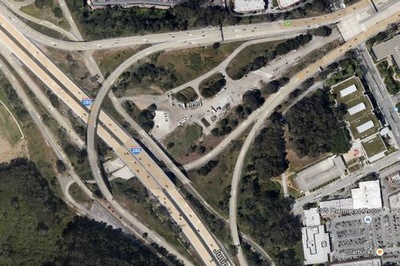
Dedication of Skyline College
1970-05-17
% complete
Dedication of Skyline College, the third college in the San Mateo County College District, and its northernmost campus. When Skyline opened, it was the first college in northern San Mateo County, and it served a large population of students. By spring 1972, enrollment had reached nearly 5,000 students.
Pictured: Skyline campus, 1970, by Isago I. Tanaka
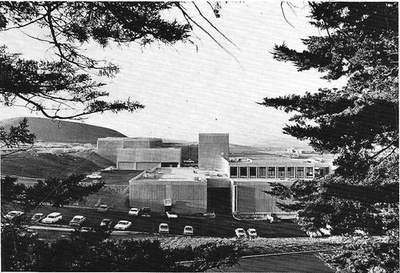
San Bruno Cable Begins Service
1971-10-19
% complete
In 1971, several Bay Area cities started their own local cable service. By 1976, San Bruno's was the only one completed and in working order. San Bruno's CATV was the second largest municipal cable system in the country. In 1999, CATV added Internet to its list of services and became one of the fastest ISPs at the time.
San Bruno Cable, now known as San Bruno CityNet Services, continues service in San Bruno and is one of the few municipally owned cable systems left in California.
Opening of Tanforan Shopping Center
1972-01-01
% complete
After a fire burned mast of the race track buildings to the ground in 1964, the land was bought for development. Beginning in 1970, a large shopping mall was built at Tanforan, and was opened in 1972. The mall was home to several major stores, including Sears and JCPenny, and it continued to operate until the late 1990s. The mall was closed for several years for a major remodel and reopened in 2005 as the Shops at Tanforan.
Pictured: The interior of the mall under construction, September 1970.
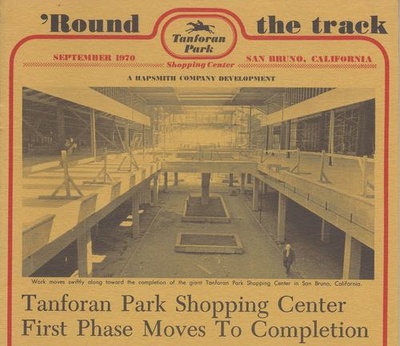
Federal Archives & Record Center
1972-12-01
% complete
The Federal Archives & Record Center in San Bruno, located on Commodore Drive, was built in 1972 to house records relocated from San Francisco, and continues to operate. The Center holds over 70,000 cubic feet of original records dating from the 1850s to the 1980s, created by Federal courts and field agencies, and by US Navy bases throughout the west coast and the Pacific.
In addition to the federal records, the Center also holds many documents relating to the history of California and the development of the west coast, including records relating to the Gold Rush, Asian-Pacific immigration, the experience of Native Americans, and the regions environmental and natural history.
Pictured: Stacks at the Record Center, July 1977. Courtesy of Harry Costa.

Election of San Bruno's First Woman Mayor
1973-03-23
% complete
In 1973, Margaret Kozkowski became San Bruno's first woman mayor. Before 1977, the position of mayor would be rotated among the members of the city council. Councilwomen Kozkowski served as mayor twice, from April 1973 to April 1974, and from April 1976 to April 1977.
After Margaret Kozkowski, two other women have served on San Bruno's city council: Beverly Barnard, who served from 1983 to 1995, and Irene O'Connell, who became a council member in 1995 and served until 2019.
Pictured: The City Council on the steps of City Hall, 1973. From left to right: John Barnard, George Corey, Mayor Margaret Kozkowski, Tony Governale, Neil Cristal. Courtesy of Harry Costa.
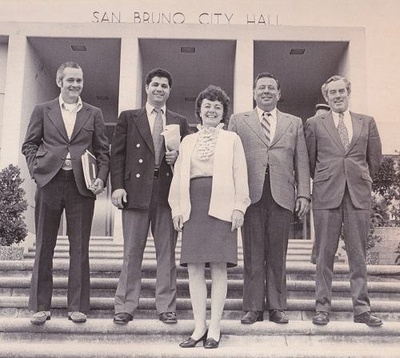
Opening of Bayhill Shopping Center
1974-07-01
% complete
Bayhill Shopping Center, the 10-acre center at the corner of San Bruno and Cherry Avenues, opened in 1974 with space for 25 stores.
Pictured: Princesses of the Bayhill Champagne Festival, June 19, 1991.
Courtesy of Harry Costa.
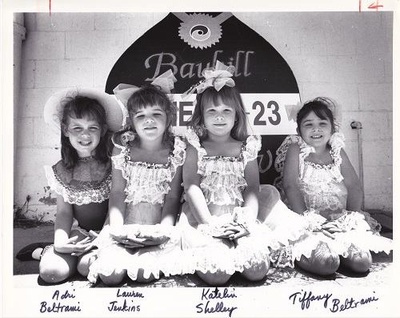
Foundation of Art-Rise
1976-01-01
% complete
A community art program, Art-Rise began as a way to raise funds for public art in San Bruno. Founded and run by longtime San Bruno resident Lois Nierenberg, Art-Rise quickly expanded its operations: it put on art shows and classes, and sold the works of local artists in their own gallery at 609 San Mateo Ave.
In 1987, Art-Rise left their studio on San Mateo Ave for Del Monte School in South San Francisco, and Lois Nierenberg retired from the foundation. Art-Rise continued to operate in South San Francisco, adding a community theater troupe to its activities, but it hit difficult times in the late 1990s and eventually disbanded.
Pictured: Art-Rise Gallery at 609 San Mateo Ave, c. 1970s
Excerpt of an Interview with Longtime San Bruno Resident, Marina Kaiser. Recorded 2014 - ArtRise
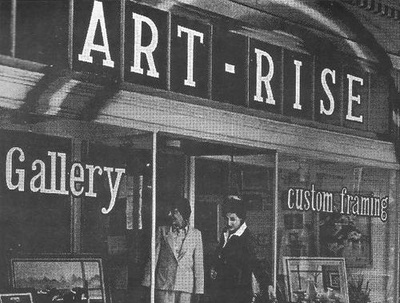
SamTrans in San Bruno
1976-07-03
% complete
The SamTrans bus system was the first major public transportation system introduced to San Bruno since the closure of the #40 streetcar line in 1949. SamTrans, which stands for the San Mateo County Transportation District, started service in San Bruno with 6 routes, including one that connected the city with the Daly City BART station and San Francisco International Airport.
Pictured: "'Welcome aboard!' exults Mayor Marge Kozkowski from the doorway of a SamTrans bus. Her fellow passengers are councilmen Gary Mondfrans (front), John Barnard and Tony Governale. Absent councilman Dick Griffith didn't miss the bus. He was on vacation." The San Brunan, July-August 1976
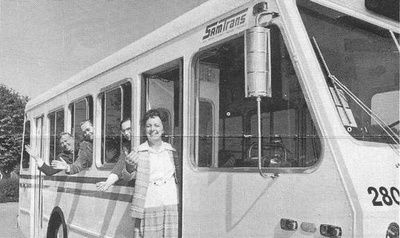
United States Bicentennial
1976-07-04
% complete
In July 1976, the United States celebrated the 200th anniversary of the Declaration of Independence and the beginning of the American Revolution. The celebrations went on throughout the year, and San Bruno joined in enthusiastically.
In addition to the marking of historical sites, memorial tree plantings, festivals and performances, San Bruno was a stop on the route of the De Anza Riders.
"Juan Bautista de Anza opened the first land route from Sonora, Mexico, to Monterey, California in the year 1774. Upon his return to Mexia, the Viceroy, pleased with De Anza's success, planned a second expedition.
When the second expedition arrived in Monterey, De Anza decided to take a few men and explore the route to San Francisco. So it happened, that on March 26, 200 years ago, an expedition of horsemen traversed San Mateo County on what is now the El Camino Real and camped overnight in Burlingame."
This expedition was reenacted in 1976, and the De Anza Riders reached San Bruno on March 27. They were met at City Hall by Mayor Marge Kozkowski, and a memorial plaque put in place.
San Bruno Herald, March 24, 1976
Pictured: De Anza Riders at San Bruno City Hall, March 1976
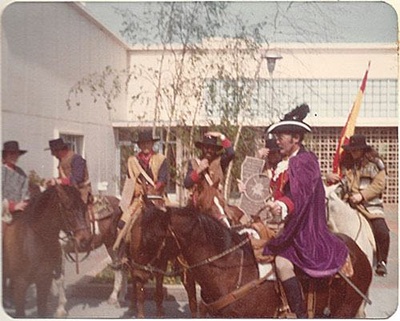
Creation of Commodore Park
1982-01-01
% complete
A large tract of land at Cherry and Commodore Avenues was set aside for a city park in 1982. Commodore Park is one of the city's largest parks and the only park with a dog run.
Airport Noise Insulation Project Begins
1986-10-01
% complete
For years, Bay Area residents living in the flight path of San Francisco International Airport had complained of the noise. San Mateo County designated SFO as a "noise problem airport" in 1971. The Federal Aviation Administration started a joint project with SFO in 1986 to insulate homes in the flight path against the airport noise. The project ran through the early 2000s and insulated nearly 3,000 homes in San Bruno.
S.F. International Airport Noise Complaints Drop over Decades
Dedication of the San Bruno Senior Center
1987-01-16
% complete
The Senior Center was built at 1555 Crystal Springs Road, just above the City Park, and was dedicated in 1987.
On August 29, 1987, a time capsule was buried at the Senior Center to commemorate the bicentennial of the U.S. Constitution.
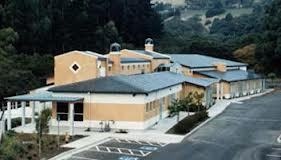
Filming of "Tucker" on San Mateo Ave.
1987-05-03
% complete
In 1987, Francis Ford Coppola was working with George Lucas on "Tucker: The Man and His Dream," a biographical film set in the 1940s about Preston Tucker and his attempt to produce and market the 1948 Tucker Sedan.
One scene called for a old-fashioned drugstore, and the perfect location was found on San Mateo Ave. Coppola's crew spent several weeks turning the former San Bruno Pharmacy at 601 San Mateo Ave into "Hensley's Drugs pf Ypsilanti, Michigan" and shooting along San Mateo Ave.
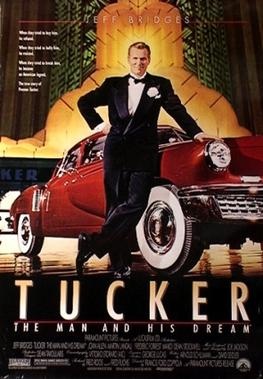
Kickboxer Ky Hollenbeck Born
1987-06-17
% complete
Ky Hollenbeck, an American Muay Thai kickboxer, was born and raised in San Bruno. He took up wrestling at age 10 and Muay Thai at 15, and won several state and national titles as an amateur fighter in his teens.
Hollenbeck became a professional kickboxer in 2007, when he won the California state belt. He continued to fight nationally until 2010, when he made his international fighting debut. In April 2012, Hollenbeck became part of the newly founded kickboxing organization, Glory, and continues to fight nationally and internationally.
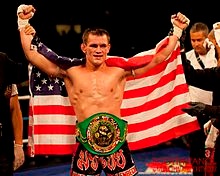
Soccer Player Efrain Burgos Jr. Born
1988-08-14
% complete
Efrain Burgos Jr. is a Salvadoran soccer player who grew up in San Bruno. He went to Westmoor High School and played soccer at San Jose State University and Cal Poly before beginning his professional career.
After playing with Toronto FC from 2012 to 2014, he signed up with the Atlanta Silverbacks. Efrain is also a member of El Salvador's men's national soccer team player pool, and was called up three times before 2010.
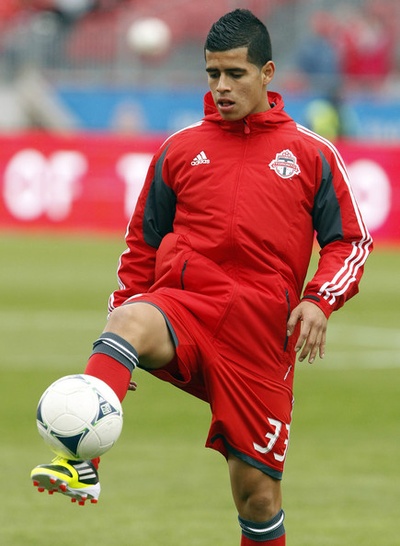
San Bruno's 75th Anniversary
1989-12-23
% complete
San Bruno celebrates the 75th anniversary of the City's incorporation.
Pictured: Float at the Posy Parade celebrating San Bruno's 75th Anniversary, June 1989. Courtesy of Jim Ruane.
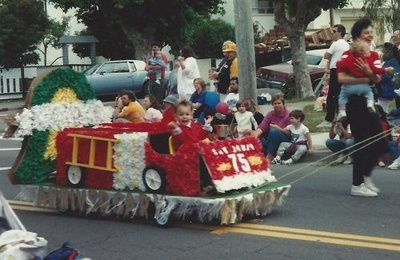
First Issue of FOCUS
1990-11-01
% complete
Focus is the official newsletter of the City of San Bruno. It is published by City Hall three times a year and sent to all San Bruno residents to keep them informed of the goings-on in their City, including official projects, plans and operations, and local events and activities.
Focus ran continuously since 1990 - 2017, when its first issue commemorated the official inauguration of San Bruno's relationship with Narita, Japan. It is a series of City newsletters, following the San Brunan, which ran for most of the 1970s.
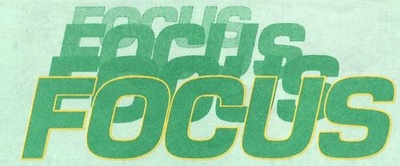
Narita, Japan Becomes San Bruno's Sister City
1990-11-09
% complete
"On November 9, 1990, representatives from the governing bodies of San Bruno and Narita, Japan met at the San Bruno Senior Center and signed a proclaimation formalizing the relationship between the two communities as "Sister Cities". A similar ceremony had been previously held in Narita on October 6, 1990. A highlight of each ceremony was the planting of a commemorative tree at the respective City Halls. An American Sycamore now grows at Narita City Hall and a Japanese Maple tree was planted in front San Bruno City Hall."
Focus, Winter 1990-91
Pictured: Narita Mayor Rokutaro Hasegawa at the tree planting ceremony, San Bruno City Hall.
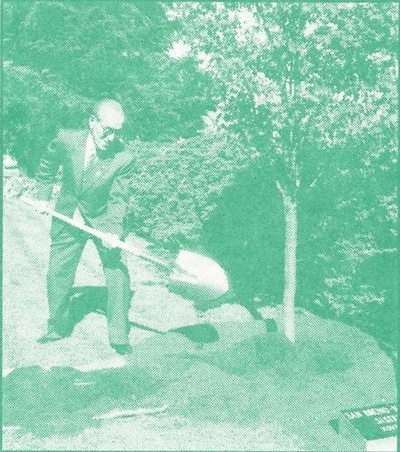
Lynn's Print Closes
1995-07-01
% complete
"Lynn Kavka established Lynn's Print Ship at Sixth Ave in San Bruno In 1941, and moved the shop to 657 San Mateo Ave in 1943. The building had previously been used as Bartozzi's Restaurant and the San Bruno Drug Store."
In 1974 Bob Perry, Betty Lucette, and Guy Foster began operating the business. and in 1981 the Coffman Family purchased the business and operated it until its closure in 1995.
Darold E. Fredricks, San Bruno People and Places
GAP Headquarters in San Bruno
1996-01-08
% complete
On January 8, 1996, the San Bruno City Council approved the construction of a new corporate campus for The Gap on a 12 acre site at the corner of Bayhill Drive and Cherry Ave. This site was part of the Bayhill Office Park Development, known as Bayhill VIII. The campus was to consist of two buildings totaling 345,000 square feet, with curving, grass-covered roofs, meant to "resemble the gently rolling foothills above San Bruno."
Construction went forward and the campus was completed in 1999, housing nearly 2,000 Gap employees. The Gap remained in the space until 2010, and the campus was then taken over by YouTube and Walmart.
Coats for Kids Started
1997-07-02
% complete
Rose Hasha outgrew her winter coat when she was in first grade in 1997. Her mother, Vicky, worked with Belle Air School to make sure the coat went where it was needed. Vicky then created Coats for Kids in San Bruno, gathering winter coats from second-hand stores and getting them to kids in need, with the help of Belle Air School. For two years, she ran the program herself, with support from her coworkers at the San Bruno Recreation Center. The program continues, and is now run jointly by San Bruno Garbage and the City of San Bruno.
Excerpt of an Interview with San Brunan Rose Hasha. Recorded 2014 -- Coats for Kids

Rotary Pavilion in San Bruno Park
1997-11-09
% complete
To celebrate their 50th anniversary, the San Bruno Rotary Club built a pavilion in San Bruno Park and gifted it to the city. The pavilion is located between the swimming pool and the Recreation Center.
First Operation Clean Sweep
1999-05-02
% complete
Operation Clean Sweep is an annual citywide clean-up event in commemoration of Earth Day. The event was created by the City's Beautification Task Force, who organize about 100 volunteers a year into teams to clean up trash, and plant flowers in City parks. The program has run continuously since 1999.
Pictured: Clean Sweep 2003
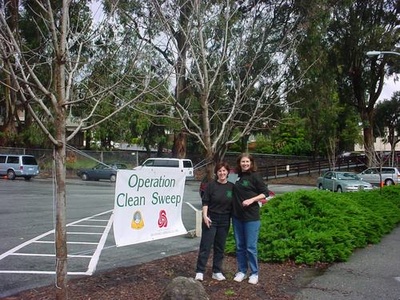
25th Anniversary of First Tongan United Methodist Church
2001-08-25
% complete
The United Methodist Church, located on El CAmino Real, was founded in 1986.
"On Saturday, August 25, 2001, San Bruno's Tongan community celebrated the 25th anniversary of the First Tongan United Methodist Church. The Tongan Consul General, City officials, and other dignitaries joined church leaders in dedicating a stone monument commemorating this important milestone for the community."
Focus, Fall 2001
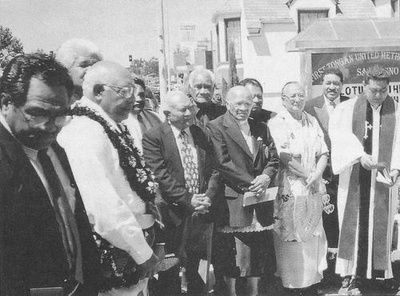
Creation of Police Plaza
2002-07-01
% complete
The San Bruno Police Department moves into new quarters behind Tanforan, next to the soon-to-be-opened BART station.
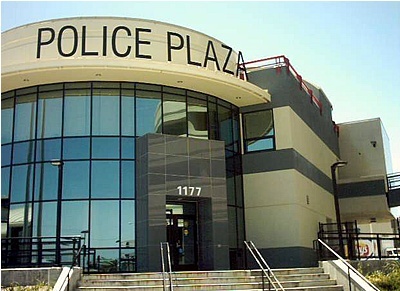
Creation of Culture & Arts Commission
2002-09-25
% complete
The Culture & Arts Commission was created to promote art in San Bruno and preserve San Bruno's diverse cultural heritage. The Commission has been responsible for several pieces of public art the City, beginning with "Journeys of the Imagination" by Gary Price, the statue pictured here, which sits on the library lawn facing El Camino Real.
They are also responsible for multiple public cultural events, including Concerts and Movies in the Park.
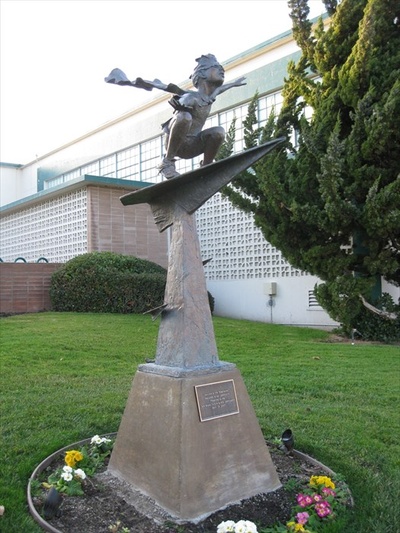
San Bruno BART Station Opens
2003-06-22
% complete
BART begins running from Colma through San Bruno to San Francisco International Airport and to Millbrae.
Voters in San Mateo County approved the extension of BART to SFO in November 1987. The Colma station broke ground in 1992 and opened for use in February 1996. From that point, the subject of BART in San Bruno was a matter for hot debate. Concerns over BART's route, the potential loss of houses or property, and whether or not BART would run underground continued through the late 1990s.
Pictured: Construction of the San Bruno BART Station, December 2000
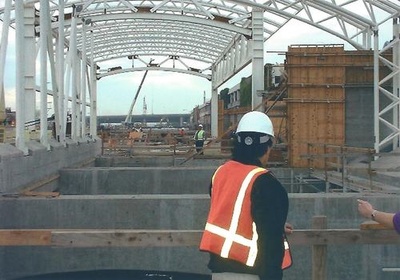
Kevin Sweeney Publishs Memoir
2003-07-01
% complete
Kevin Sweeney, born in San Bruno in 1958, is an environmental consultant in the Bay Area. He wrote Father Figures, a memoir about growing up in San Bruno following the death of his father when he was three and a half years old.
Father Figures tells of going to school at St. Roberts, playing in streets and backyards with his many siblings, and, most importantly, his relationship with the three men he chose to be his "father figures," who helped to guide him to adulthood after the loss of his own father.
Pictured: Cover of Father Figures
The Sunshine City / Kevin Sweeney Memorializes the San Bruno of his Youth
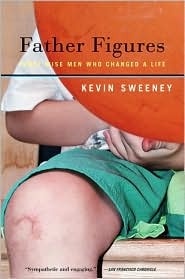
The Crossing Is Completed
2005-07-01
% complete
The former Navy Facility on El Camino Real was transformed into a complex of affordable housing and senior apartments in the early 2000s. The first phase of this redevelopment project, known as Meridian Apartments, was completed in mid-2005. Phase two, a senior housing complex known as The Village, was completed in early 2007.
Pictured: Construction of The Village, 2006.
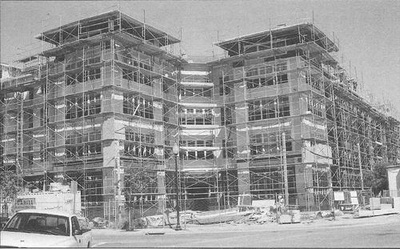
Shops at Tanforan Reopens
2005-10-02
% complete
Tanforan, which, over its more than a hundred years of existence, had been a landing field, a racetrack, a training ground, an internment camp, a military post and a shopping center, opened in its latest incarnation in 2005.
The Tanforan Shopping Center, which had been struggling through the 1990s, closed in 1999 and a major renovation project began in 2003. When the mall reopened in October 2005 as the Shops at Tanforan, it hosted such big names as Barnes & Noble, Sears and JCPenney, in addition to its smaller tenants. Century Theaters opened its location at Tanforan in April 2008.
Rotary International Centennial Clock
2006-01-05
% complete
To celebrate the 100th anniversary of Rotary International in 2006, the San Bruno Rotary Club donated a 16-foot tall clock to the city, which currently stands at the corner of Jenevein and San Mateo Aves. The clock was dedicated on January 4, 2006, in a ceremony attended by Rotary Club members, local business merchants and members of San Bruno's Chamber of Commerce.
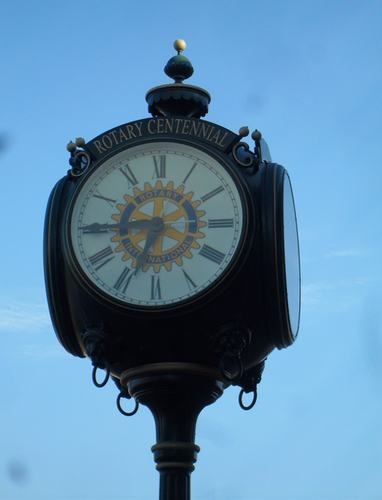
YouTube Headquarters in San Bruno
2006-06-01
% complete
YouTube.com went live on February 14, 2005 and since 2006, YouTube has had its headquarters in San Bruno. It has found a home for most of this time in the Bayhill Office Park, moving into part of the Gap corporate campus at Cherry Ave and Bayhill Dr when Gap moved out in 2010.
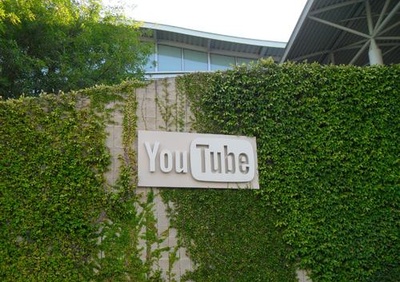
Rededication of Recreation Center
2006-06-02
% complete
The War Memorial Recreation Center in San Bruno Park is rededicated the Veterans' Memorial Recreation Center in 2006, to celebration the Center's 50th Anniversary.
Pictured: Unveiling the Recreation Center's new name, June 2006
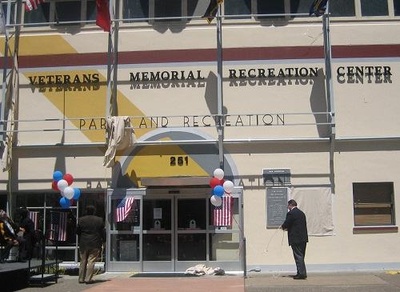
A Dreamer's Song Dedicated
2007-07-01
% complete
In 2007, the City created a pocket park at the intersection of Jenevein and San Mateo Aves, at the former Wells Fargo site. The park features five murals by San Bruno artist Boris Koodrin. These include a horse race and a woman aviator, recalling the history of Tanforan Race Track and the San Francisco International Airport.
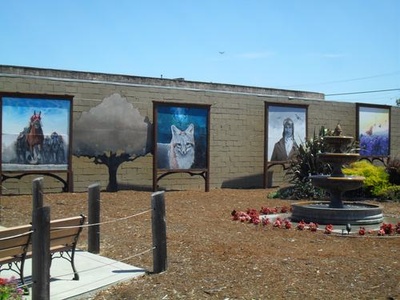
"Break Time" at the Library
2009-11-03
% complete
The San Bruno Culture & Arts Commission placed a new statue, entitled "Break Time," in front of the library on Angus Ave. The statue of two children reading on a tree branch was donated by the Carlton Corners Association, which administered the community gathering place Carlton Corners from 1936 to 2009.
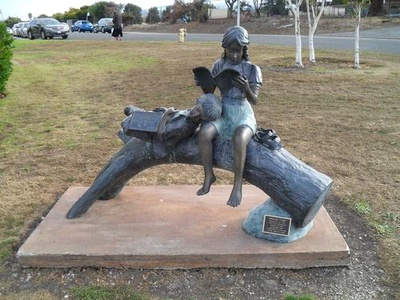
Walmart.com in San Bruno
2010-05-01
% complete
When Gap moved out of its corporate campus on Cherry St., Walmart.com leased the 266,000 square foot office building at 850 Cherry Ave from Gap and moved its own headquarters and more than 1,300 employees in.

Gas Explosion and Fire
2010-09-09
% complete
On the evening of September 9, 2010, a gas pipeline in the Crestmoor neighborhood exploded, destroying 35 homes and killing 8 people.
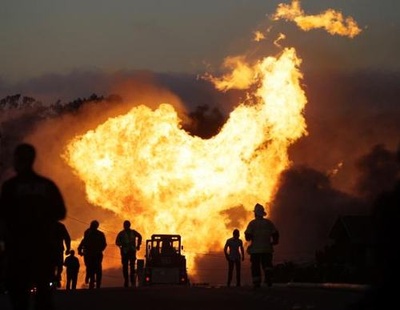
Demolition of San Francisco County Jail
2012-01-16
% complete
In 1932, the County of San Francisco purchased part of R. G. Sneath's Jersey Farm Dairy Ranch #2 and built San Francisco County Jail #3 near the present day site of Skyline College. Also known as "Sunshine Jail Farm," for the vegetable gardens tended by inmates, this jail held those sentenced for misdemeanors and other minimum security prisoners.
Beginning as early as 1945, conditions in the jail began to deteriorate, and it faced serious overcrowding issues and concerns over physical conditions. Beginning in the 1980s, efforts were made to improve conditions in the jail, but it wasn't until 1996 when a successful bond measure was passed that funding became available for a new facility. San Francisco County Jail #5 was built on the same land and opened in 2006. The inmates were transferred to the new facility and Jail #3 was decommissioned, then demolished in 2012.
First Crestmoor Survivors Enter New Homes
2012-05-14
% complete
After extension recovery efforts, the first survivors of the Crestmoor fire entered their newly rebuilt homes.
Pictured: Construction on one of the homes being rebuilt in the Crestmoor neighborhood
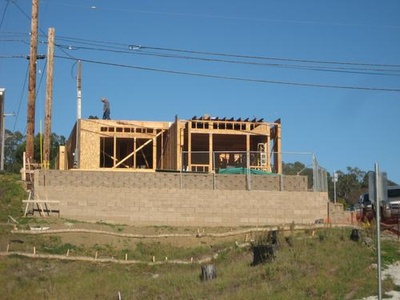
Dedication of "Reflections"
2012-06-28
% complete
In 2012, the statue "Reflections" was dedicated in San Bruno Park to those "who have touched the hearts and lives of the community through their service to the City of San Bruno."
On September 9, 2012, the second anniversary of the Crestmoor Fire, the first plaque was added to the statue, memorializing the eight people who lost their lives in the fire.
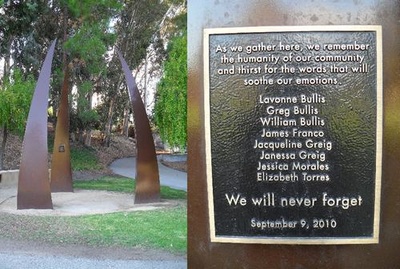
El Camino Groundbreaking Centennial
2012-08-07
% complete
Caltrain Grade Separation Completed
2014-04-02
% complete
After a planning stage that lasted for many years, construction on the Caltrain grade separation project began in 2010. Caltrain has run through San Bruno since 1962, and the tracks have run at ground-level along Huntington Ave for that time. Increasing concerns about the safety of pedestrians and cars crossing the tracks inspired the decision to elevate the Caltrain tracks where they cross San Bruno, San Mateo and Angus Aves.
Construction continued through 2013 and trains started using the new, elevated tracks on May 26, 2013. A new station was constructed at the intersection of San Bruno and San Mateo Aves and opened to passengers on April 1, 2014.
Pictured: The new Caltrain station at San Bruno and San Mateo Avenues.
Photograph courtesy of Fullmetal2887.
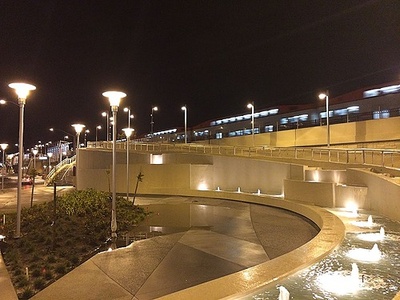
Centennial Tree Project
2014-07-01
% complete
To celebrate the Centennial, the Beautification Task Force works to plant 100 street trees in San Bruno neighborhoods.
San Bruno Honors it Centenarians
2014-11-15
% complete
As San Bruno celebrated its hundredth anniversary, it also celebrated the hundredth birthdays of several of its citizens.
Pictured: Catherine Murphy, who lived in San Bruno for many years and who turned 100 in 2014, receives a proclamation from the City celebrating her birthday.
